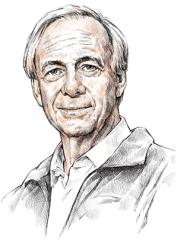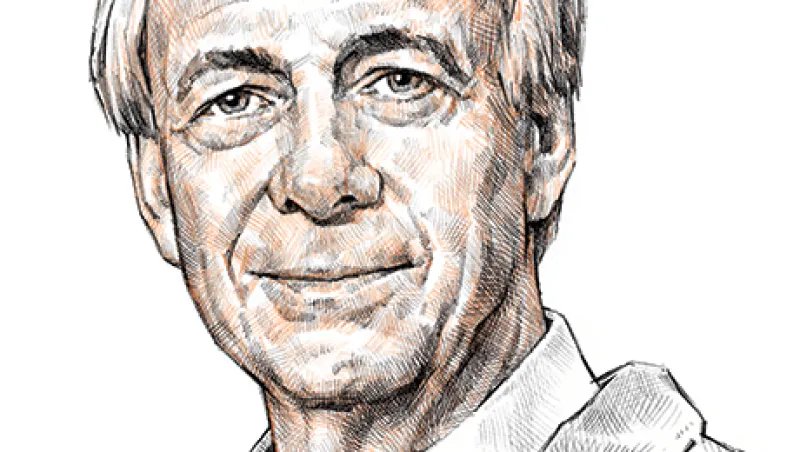Few asset managers were better prepared for — or benefited more from — the financial crisis than Raymond Dalio. The 64-year-old chairman and co-CIO of Bridgewater Associates has been studying the intricacies of the markets since he famously founded the firm in 1975 out of a two-bedroom Manhattan apartment. Dalio’s goal is to discover what he calls the “timeless and universal truths” about the economy, which he likes to compare to a machine. Bridgewater’s research during the late 1990s on financial dislocations and the deleveraging process led to the development of measures that helped the firm anticipate the impending crisis as early as 2006. The next year, as the subprime mortgage market was unraveling, Bridgewater warned readers of its popular “Daily Observations” newsletter about the “crazy lending and leveraging practices.” In April 2008 the firm wrote that financial markets had reached a point in their evolution “where the role of banks will once again change for the worse.”
Dalio and Bridgewater were spot-on. The global banking industry lost more than $500 billion in 2008. Bridgewater, meanwhile, prospered. That year its flagship Pure Alpha strategy — a macro hedge fund that invests in bonds, commodities, currencies and equities in more than 100 markets around the world — was up 8.7 percent after fees. Institutional investors flocked to the firm, whose hedge fund assets have grown from $36 billion at the start of 2008 to $85 billion. (The firm manages $145 billion overall.)

Institutional Investor: Bridgewater was one of the few asset managers not blindsided by the financial crisis. To what do you attribute your success?
Dalio: At the highest level it is our culture. Bridgewater operates in very different ways from most firms, and that drives our different results. In this case it was because we view everything to be like a machine that keeps doing the same things over and over again, with some of the most important ones happening about once a lifetime, so most people are surprised by them. Big deleveragings are one of those because they happened in the past and because to understand how the economic machine works, we need to understand how they happened, so we studied them. We’ve studied most bubbles and busts — like the 1925–’35 period in the U.S., the 1975–’85 period in Latin America, the 1985–’95 period in Japan — so we had a good template. If you want to see how our template works, it will soon be viewable in a 30-minute video on [Bridgewater website] principles.org [via YouTube].
So you had been doing research on deleveraging well before the most recent crisis?
Yes. We had created what we call a depression gauge eight years before the crisis to capture the depression dynamic: when there is debt contraction that cannot be reversed through a lowering of interest rates because rates are already close to zero.
When did the gauge indicate that we were in trouble?
It was very apparent in late 2006 that we were in a bubble, which swelled to an unsustainable level in 2007. When you have a situation in which debt is rising faster than income and that debt is used to buy goods, services and financial assets that won’t throw off cash to service the debt, it’s clear that assets are going up for unsustainable reasons. It’s like if I borrow a lot of money to have a big party and I hire the caterers and band, it looks like I’m very prosperous, but that is misleading because it’s financed by debt that will have to be paid back. During such a period an anomaly occurs: The rate of debt growth is very fast and produces wealth because some of the debt goes into the purchase of financial assets. And even though the debt is rising at a fast rate, credit spreads go down. That makes no sense. It’s logical for credit spreads to increase because there’s more debt risk. But these things happen because of human nature. When markets go up in price, people tend to extrapolate the past. They say there is “low credit risk, lots of liquidity, and everything will continue.” So that happened in that 2006–’07 period.
How did you position Bridgewater’s portfolio during that period?
We have a whole lot of uncorrelated bets, so there wasn’t any one theme that was dominant, though if there was one that was larger than the others, it was long safe assets and short risky assets. For example, at the time, we were in sovereign bonds that didn’t have credit risk; we were long the yen, long gold, and we were short a range of risky assets.
Another key principle of ours that played a key role at the time was to not have any systematic bias to be long or short anything. There is no good reason for us to lose money because we have no bias. Our only reason for losing money is being wrong. That’s different from most other managers. Why did almost all other managers lose money in 2008? Because they had systematic biases.
Critics of quantitative easing say that the Federal Reserve’s actions have artificially inflated the prices of risky assets.
That’s the process. Quantitative easing means really putting money into the system. Debt is a promise to deliver money, so it’s a short money position. To relieve that short money position, the central bank puts money into the system to make it easier to service debt, and it does that by purchasing financial assets. The central government can buy goods and services or give money to people, but the central bank is only authorized to buy financial assets. As asset prices go up, people feel wealthier. On a mark-to-market basis, the assets are worth more. So people will borrow and spend more. That’s the usual dynamic. People borrow and spend, and the debt process gets going, and that’s the wealth effect. And that’s the way economic policy works because we have that bias in our portfolios. It’s a longer-term challenge because it doesn’t put the attention on productivity and the things that actually matter more.
If you were Fed chairman, what would you be doing now?
The central bank must pay attention to whether the debt that is being created can be serviced. If you’re just looking at inflation and growth and you’re creating debt that is for the purchases of other things — houses and things that are not going to produce enough income to allow the servicing of that debt — you’re responsible for debt growth. We’re in a situation where you want to make sure the debt growth and debt serviceability are favorable relative to income growth. At this time, the economy has largely returned to normalcy because of the Fed’s action and, at the same time, it’s still overly indebted. So the Fed lessening the force of its foot on the gas is appropriate. But, of course, how much it applies the gas and the brakes always should be in response to how fast debts are rising relative to income. The No. 1 rule should be don’t let debt rise or fall too much relative to income for long.
It sounds like you’re pretty comfortable with the way the Fed has handled the crisis.
I think they’ve handled it masterfully. I think Ben Bernanke should be considered a hero who has saved the world from a great depression.
What are the biggest risks to the economy right now?
The risks that exist now are the emerging markets, particularly related to China. There’s a dynamic that’s changing that would mean that emerging-markets countries dependent on foreign capital can encounter more problems. But generally speaking, there are always such risks. I don’t think right now is a particularly high-risk environment.
The big risk is in the next downturn, which can come in two to four years. I question the issue of the effectiveness of QE in that downturn. There’s a problem if you do more QE and pump up asset prices; it drives down expected returns. It will be interesting to see what the flow of money will be when those asset prices pump up so high that their expected returns are so low that investors have to buy assets with no returns and with risk levels that are high. • •
Illustration by Bernd Schifferdecker
The Legacy of Lehman: A Look at the World 5 Years After the Financial Crisis
- 5 Years After Lehman, No One Can Declare the Financial System Safe
- Europe's Banks, Slow to Restructure, Pose a Systemic Risk Today
- Emerging Markets Face Mounting Challenges as Global Liquidity Dries Up
- As the Fed Readies to Taper, Is the World Ready for Higher U.S. Rates?
- China Exploits Crisis, Positions Renminbi as Potential Rival to Dollar




